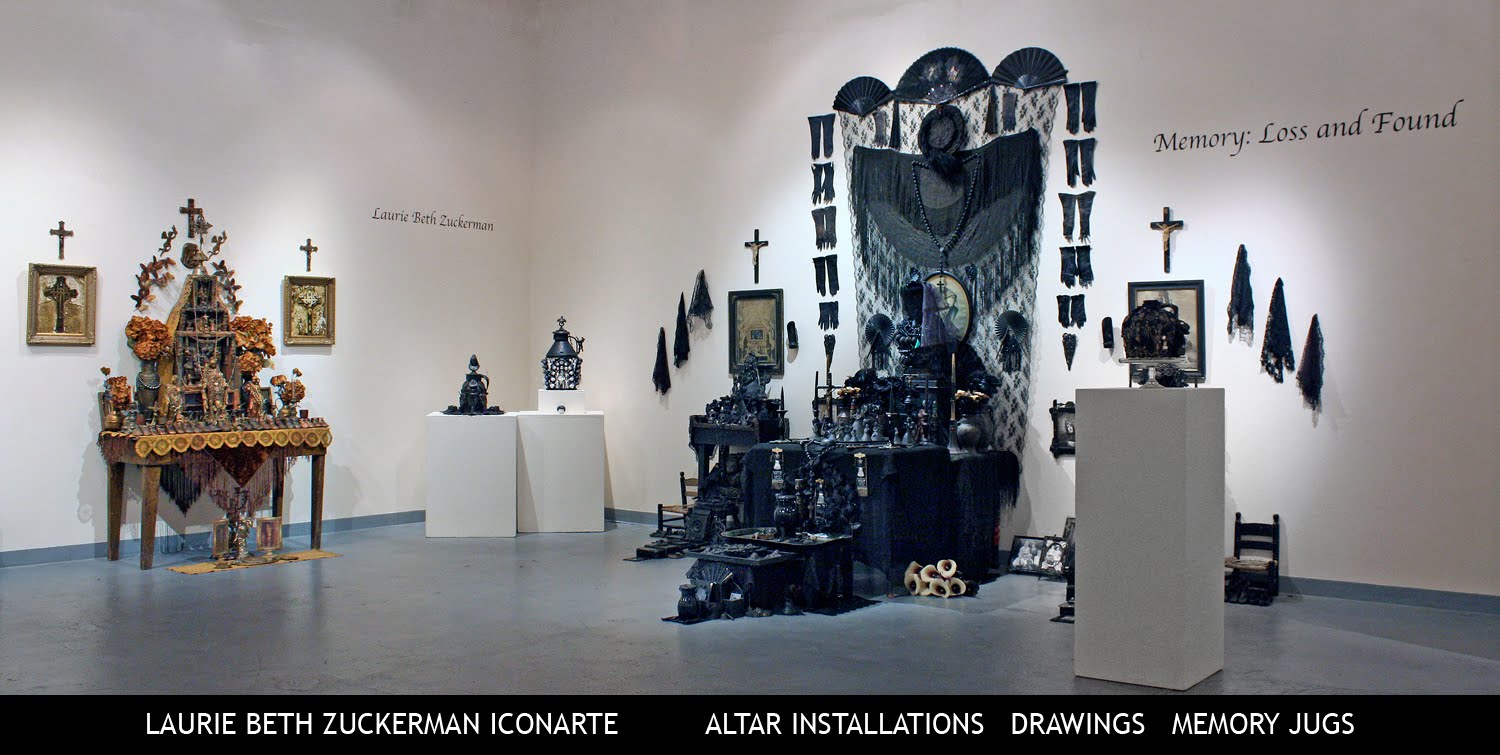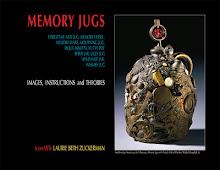 |
| Laurie Beth Zuckerman's "Madre Dolorosa: The Spanish Lady" installation includes three altars and three memory jugs at The Dairy Center of the Arts |
 |
| Laurie Beth Zuckerman's Memory: Loss and Found altar installations at the Dairy Center for the Arts in Boulder, Colorado |
 |
| Laurie Beth Zuckerman's Madre Dolorosa: The Spanish Lady altar installation center closeup, Dairy Center for the Arts, Boulder, Co. |
 |
| Laurie Beth Zuckerman's Memory: Loss and Found installation at the Dairy Center for the Arts in Boulder, Colorado |
 |
| Laurie Beth Zuckerman's Memory: Loss and Found installation at the Dairy Center for the Arts in Boulder, Colorado |
 |
| Laurie Beth Zuckerman's "Bella Donna" altar installation at The Dairy Center |
 |
| Laurie Beth Zuckerman's "Bella Donna" altar installation at The Dairy Center. Donna Zuckerman is pictured on her wedding day with her husband, Irving Stone. |
 |
| Laurie Beth Zuckerman's "The Tarnished Angels" altar installation at The Dairy Center |
 |
| Laurie Beth Zuckerman's "Madre Dolorosa: The Spanish Lady" altar installation, grandma's empty rocking chair and suitcases at The Dairy Center |
 |
| Laurie Beth Zuckerman's "Madre Dolorosa: The Spanish Lady" altar installation with "Locked Away" memory jug at The Dairy Center |
|
|
| Laurie Beth Zuckerman's "Madre Dolorosa: The Spanish Lady" altar installation with "The Bell Jar" memory jug at The Dairy Center |
 |
| Laurie Beth Zuckerman's "Madre Dolorosa: The Spanish Lady" altar installation with "Locked Away" and "The Bell Jar" memory jugs at The Dairy Center |
 |
| Laurie Beth Zuckerman's "Behind the Eight Ball" memory jug made in 2003 is included in her altar installation at The Dairy Center |
Laurie Beth Zuckerman's altar exhibition at The Dairy Center for the Arts in Boulder is entitled, "Memory: Loss and Found." This is a joint exhibition with my dear friend, mosaic artist Susan Wechsler of Boulder County, Colorado. Susan and I collaborated in her Longmont studio last year, sharing each others personal techniques and artistic sensibilities with found-object assemblage. We have planned this exhibition since March 2013, each creating new works expressly for our theme and The Dairy Center venue. Our exhibition is unique and outstanding, and I am grateful to Susan for suggesting this joint venture. Few other artists are as obsessive and meticulous about their artwork as we are.
Our exhibition title, "Memory: Loss and Found" plays with grammar to make a point. Both of us have created works that reflect "losses" we have experienced, and to make a statement about what is "found" by examination of and reflection upon memory. Some observers may reflect that the found objects and personal items used in our works are imbued with the energy and spirit of those who once possessed these things. My altars are constructed primarily from antique Victorian mourning paraphernalia, Mexican black clay folk art from Oaxaca, and a host of vintage collectibles.
I made these Madre Dolorosa altars and memory jugs in remembrance of my Russian-Jewish ancestors and their tragic life stories, which have colored my life with a somber gloom. This black cloud has hovered over me as long as I can remember. My altars are manifestations of these family legacies, told to me by my storytelling father, Hollywood screenwriter and novelist, George Zuckerman. My father used words meant for moving images or the printed page to tell his stories. I use historical objects in a physical manner to express my own take on these deeply personal stories. I aim for a visual shock and awe reaction from my viewers—I want people to feel my work in their gut.
My "Madre Dolorosa: The Spanish Lady" altar installation includes three individual altars, plus a rocking chair display. This suite honors the sadness my Grandmother Sarah Melnik Zuckerman, and her only daughter, my Great Aunt Elizabeth Zuckerman, who died at the age of six during the 1918 Spanish Flu pandemic, aka "The Spanish Lady." Sarah lost her mind, fled home, and lived away for two years, abandoning her three sons, the youngest of whom was my two-year-old father. My father named me Beth, out of respect for his older sister, Elizabeth. It would have been too much for my Grandmother Sarah, if my parents had named me Elizabeth.
My "Madre Dolorosa" installation includes a suite of three memory jugs, two of which honor the massacre of nearly thirty Melnik/Zuckerman relatives during the Nazi invasion of Poland in July 1941. Their titles are "Behind the Eight Ball" and "The Bell Jar." The third memory jug, "Locked Away" honors the memories of her lost daughter that were locked in my grandmother's fragile mind, and remained secret from her four surviving sons. My teenage father did not know he had a sister until he discovered a trunk of Elizabeth's belongings in the attic.
My "Bella Donna" altar installation honors my first cousin, Donna Zuckerman and her new husband, Irving Stone, who died in a single car crash on their honeymoon to Canada. They were buried one week after their nuptials in Brooklyn, New York, 1973. I was not in attendance for either life-altering event, but my brother, Gregg Zuckerman was. I was living across the country in Eugene, Oregon. I had just graduated from the University of California at Berkeley, and arrived in Eugene just days before Donna and Irv passed away. My sense of hopefulness for life and happily ever after died the day my mother called to relay the devastating news.
All three of my altar installations and four memory jugs in this exhibit are a part of my Memento Mori series. Memento Mori is a Latin phrase for “be mindful of death" that can also be interpreted as “remember that you are mortal.” Memento Mori refers to the historic genre of artistic creations in European funereal art, cemetery tombstones, and architecture, and include the Mexican El Día de los Muertos imagery used on ofrenda altars. Our exhibit was scheduled to coincide with El Día de los Muertos, and will close after the holiday on November 4.
To see an earlier installation of my Madre Dolorosa Altar that I exhibited in 2012 at the Longmont Museum and Cultural Center in Colorado, click on this blogpost.
To see an earlier installation of my Madre Dolorosa Altar that I exhibited in 2012 at the Longmont Museum and Cultural Center in Colorado, click on this blogpost.
 |
| Laurie Beth Zuckerman (left) and Susan Wechsler (right) congratulate each other on their exhibit at the Dairy Center for the Arts |
 | |
For more information about Laurie Zuckerman and Susan Wechsler's exhibition, please log onto The Dairy Center for the Arts for show times and dates. Please visit artist, Susan Wechsler at her website and blog: http://www.mosaicsbysusan.com |







